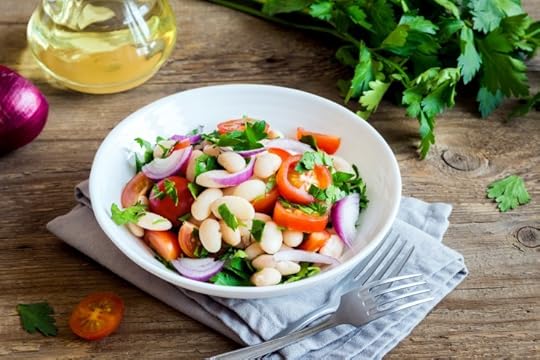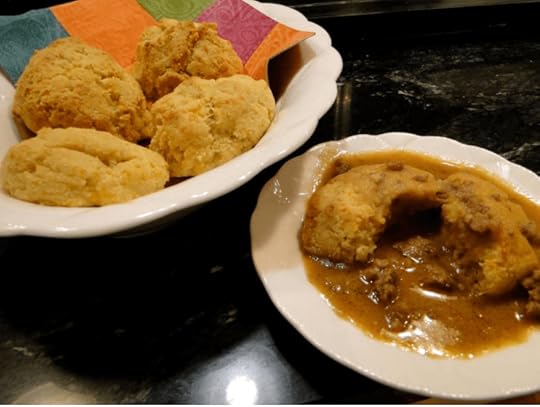William Davis's Blog: Dr. Davis Infinite Health Blog, page 44
June 9, 2019
Lose your wheat tooth

Remove wheat and other closely related grains, especially rye, barley, corn, and oats, and your taste perception changes: flavors become sharpened, more pronounced. It leads people to say such things as “I used to hate Brussels sprouts, but now I love them.” Or “I can no longer eat fast food because of the excessive sugar, salt, and synthetic flavors.”
Removing the taste distortions of wheat and grains also sharpens your sensitivity to sweetness, making formerly tasty, sugary treats sickeningly sweet. Many find that candy bars, soda, or sugar in their coffee become intolerable, so cloyingly sweet that they are inedible or undrinkable.
Combine these alterations in taste perception with removal of the factors in wheat and grains that increased appetite, and those of us following the Wheat Belly lifestyle have no problem avoiding sweets: we lose our desire for them and they taste awful when we eat them.
So when people contemplating the Wheat Belly lifestyle declare “My problem is not wheat or grains—it’s sweets!” they are failing to understand the taste-altering and appetite-reducing benefits of banishing wheat and grains from their lives. Having a persistent sweet tooth is distinctly uncommon after removing wheat and grains, though the effect may require several days to weeks to fully develop. The primary, driving problem is therefore not the sugars for most people; it’s the wheat and grains. Lose the wheat, lose the grains, lose desire for sweets.
I still recognize that an occasional lightly sweetened dessert or treat may be fun to have, or you need them to entertain company, enjoy a holiday dinner, or please the kids or grandkids—the social obligations you may have. This is why I provide recipes here and through the Wheat Belly cookbooks. I learned years ago that have this occasional option for indulgences to navigate social situations increased adherence and satisfaction with this program without risking re-exposure to the awful effects of wheat and grains.
However, if you are among the minority of people who have a sweet tooth persist even after you make the leap to being wheat- and grain-free, then consider this:
Are you truly wheat/grain-free? Or are you continuing to be exposed to a grain component in, for instance, your nutritional supplements or prescription drugs that continues to stimulate appetite and distort taste?
Are you still limiting fats and oils? If so, stop it! There is NO health advantage to limiting fats and oils. Use more butter, coconut oil, olive oil, and choose fatty cuts of meat and eat the fat. Never choose low- or non-fat dairy products. And if some of your oils are medium-chain triglycerides, MCTs, this will reduce your desire for sweets even more.
Do you have small intestinal fungal overgrowth, SIFO? Fungi, such as Candida albicans, glabrata, and tropicalis, have the peculiar capacity to stimulate your appetite for sugar. It’s creepy to know that fungi have control over some aspects of the human mind and behavior. When fungi proliferate and ascend up the gastrointestinal tract–small intestinal fungal overgrowth—they can stimulate your desire for sweets, tricking you into consuming a food that they like to consume, since fungi thrive on sugars.
Do you lack Lactobacillus reuteri in your intestinal microbiome and thereby have lower blood and brain levels of oxytocin? Recall that L reuteri is a microorganism that most people harbored in their intestinal microbiome up until the mid-twentieth century. Most modern people no longer have this species, part of the disaster of changes inflicted on bowel flora in twenty-first century life. Because L reuteri has the unique capacity to provoke hypothalamic release of oxytocin that is a powerful appetite suppressant, lacking L reuteri and thereby oxytocin may underlie a continuing desire for sweets. Remedy: make L reuteri yogurt.
You can appreciate that the Wheat Belly lifestyle is not just about banishing grains, nor limiting carbs or calories. Unlike a simple diet program, the Wheat Belly (and Undoctored) lifestyles take health and life several steps further for maximum health advantage.
The post Lose your wheat tooth appeared first on Dr. William Davis.
June 6, 2019
Eight years of Wheat Belly successes

I was looking back over the last 8 years since the first Wheat Belly book was released. It’s been 8 years of astounding, truly breathtaking stories of success over weight issues, health, and physical transformations that skeptics even today claim are impossible. It’s been a virtual avalanche of wonderful stories. Although I’ve seen all of them, often more than once, I could not help but be overcome with satisfaction and pride for the many, many spectacular photos and stories people have shared.
So I thought it would be fun to re-post a small sample of some of these stories dating back from the start of the Wheat Belly lifestyle back in 2011. If you see yourself in this post, please post an update!
2011–Anonymous
“I have had suffered in secret with what I thought was bulimia for 30 years. I can’t even believe it, but since giving up gluten I no longer have the urge to throw up. I used to feel sick after nearly every meal. I seriously thought I would eventually die from an injury to my esophagus.
“I have not felt sick even once since giving up gluten. Not once. I feel free for the first time in memory.
“I am astounded by how different my body feels, and I never even knew how bad I felt because it was all I ever had felt…it was my “normal.” I had to share this with someone and because my “eating disorder” has been completely in secret, I can’t tell anyone I know.
“(I should mention that about 10 years ago I was tested for celiac disease because I have extended family members with confirmed diagnoses, but all my tests were negative.) I don’t care what their tests say— I will never eat wheat again.
“My family laughs when I say this because I have never stuck to a diet in my entire life, but this is different. I feel in control of my body for the first time. I am near tears writing this. I can’t believe my struggle is over and I won:)”
2012–Jenn

“Going wheat-free has been a life changer.
“At my worst, I was experiencing heartburn, foot pain and swelling, back pain, coughing and head-aches. I was afraid to go to the doctor for fear of what he would tell me.
“Now, I am 180 days in and 72 pounds down. The wheezing has stopped, I sleep better at night and I am not having foot pain and swelling — and the headaches and heartburn have disappeared completely. I went from not being able to tie my own shoes without getting out of breath to running and working out.
“Going wheat-free has given me the opportunity to live a normal, active life again and to enjoy playing soccer with my kids!”
2013–Lisa
“About 3 years ago I was struggling with crazy inflammation: moderate at times, but also spiking and leaving me barely able to walk.
“I was turning 40 and felt 90. Doctors diagnosed me with ‘fibromayalgia’ and ‘autoimmune disorder–etiology unknown’ and gave me pain pills and steroids, which I tried but the side effects were terrible. I knew they weren’t the answer, but I had no idea how to figure out what was wrong.
“I basically suffered for years until I found your book. Within a week–-days, really-–of staying away from wheat, my pain was gone. My stomach issues, which had plagued me for several years, as well: gone.
“I climbed a mountain on my 43rd birthday with my two daughters. Two weeks prior (before I found your book) I could barely climb the stairs. At the top of that mountain, I cried like a baby, so thankful for the chance to do this with my girls and live a full life again. Sometimes I can’t believe I feel this good.
“I now row on my rowing machine 1500 meters a day, and will do more as times goes on. It feels great: no joint pain, no trigger points. I could go on and on here, but all I really need to say is thank you.”
2014–Cindy
“I have been wheat-free since reading your book 10 weeks ago and have lost 14 kilos [30.8 lbs] in those 10 short weeks! I have NEVER been able to lose more than a few kilos at a time and, when I did, it always came hurtling back, fatter than ever each and every time.
“Before I read Wheat Belly, I was in constant turmoil over eating, I couldn’t understand how the educated, intelligent, strong-willed person I believed myself to be could be totally defeated by food and food cravings.
“I was always bloated (huge wheat belly!), lethargic, anxious, angry, irrational, depressed and always hungry, a perpetual, desperate, and insatiable hunger that persisted despite being stuffed full (with wheat and wheat products!). I was completely exhausted by my preoccupation with eating, not eating, dieting, binging, crying, hating myself, dieting again, binging, hating myself — I was at the end of my rope. Until Wheat Belly…
“After cutting out the wheat (and all processed junk) I could barely believe the feeling of calm that descended upon my life. The weight dropped off, depression lifted and I, too, experienced all of the amazing things everyone else has reported.
“I now love food, but I rarely think about it anymore or, should I say, obsess about it anymore. I haven’t counted one calorie, have never considered the fat content of the organic meats and whole foods I am enjoying, and the weight continues to drop off. I have started exercising just because I have so much energy and I feel like jumping around. I feel amazing, like I can truly start living the rest of my life as it was meant to be lived, something I honestly thought I was (sadly) never going to be able to do. I am free.”
2015–Jean

“Left upper to right lower represents 11 months and 67 lbs. My starting weight was 221 and, in the last picture, I weighed 154.
“I have been wheat-free since July and totally grain-free since August.This weekend I had a breakthrough. I spent the whole weekend performing projects. Saturday, I cleaned and swept the garage, which included moving boxes of full canning jars. Then, on Sunday, my husband and I planted 108 plants in the garden.Neither morning did I wake up in pain. Considering that I have chronic osteoarthritis, this is a huge victory for me. There were days when I couldn’t get out of bed the next day after doing a project. I am absolutely stunned that I am not in pain.
“I wish everyone with inflammatory diseases would learn about how to live pain free in a natural way.”
2016–Karen

“The first pic was from Christmas, 2014. I started Wheat Belly on Oct 15th, 2015.
“In 3 months, I went from 224 all the way down to 185! My husband also went from 278 down to 242.We exercised, too, about 30 mins a day, 6 days a week. We also walked on trails with our dogs for about 45 mins on Saturday and Sundays.
“I was pre-diabetic, depressed, sick, achy and had IBS, fibromyalgia, anxiety, and panic attacks, now all reversed. I can’t believe how I looked. I’m so happy now. I’m 40 pounds away from my goal, which is 150, but I will get there.”
2017–Susan

“Started Wheat Belly Sept. 2017 left pic. Oct. 2017 top right pic inflammation was way down face color was still pretty bad. November 2017 middle right pic skin tone is much better and then last bottom right pic was Jan 2018 on my 4th month anniversary.
“Down 12 pounds but it is so much more than that. No migraines, reduced joint pain, no brain fog, my tummy feels good! Lots to smile about now! Love the support and encouragement from everyone. It has been life changing for me!
2018–Adam

“June 2nd, 2017 on the left, I was 2 months gluten-free, pre Wheat Belly 10-Day Grain Detox. December 13th, 2018 on the right. I am 7 months since the 10-Day Detox.
“No more medications for sleep or allergies. I sleep better that I have in years. More energy. Less gray hair, more stamina, rarely hungry, and I can walk or hike several miles without having to stop multiple times to catch my breath.
“This Way Of Eating has benefited me in more ways than I could have imagined. For those just beginning, stay on the path and keep moving forward. The rewards are worth every moment.
“People no longer think my kids are my grandkids. Several ladies had commented to my wife on how good I look.”
2019–Luisa

“2017. Tired, in pain, eating gluten free but still with a lot of troubles. I have PCOS and I’m celiac. I had sleep problems, inflammation, constant pain, headache and migraines and was depressed.
“2018. I had been doing Wheat Belly for 3 months feeling much better, my symptoms are gone, losing weight and feeling much better.
“2019. Today I am very thankful for Dr. Davis research, because otherwise I won’t be feeling like I feel today, happy and healthy.
“BTW. I’m 43 today!”
The post Eight years of Wheat Belly successes appeared first on Dr. William Davis.
June 5, 2019
Why is quinoa getting a free pass?

A day doesn’t pass that I don’t see some new “healthy” recipe for quinoa, or a dietitian or nutritionist gushing about the health benefits of this seed.
Many make the claim that quinoa is high in protein and is gluten-free. Clearly, the gluten-free movement is fueling some of this excitement over this seed. But how much truth are there in these claims? And just how healthy is quinoa as a replacement for grains?
Let’s tackle these claims one by one:
Quinoa is not a grain and is gluten-free
This is absolutely true. While all grains, or seeds of grasses, are members of the family Poaceae, quinoa is not; it is a member of the family Amaranthaceae that includes spinach, beets, and some ornamental shrubs. It therefore does not have the gluten proteins of wheat, rye, or barley, nor anything resembling the zein protein of corn nor the avenin of oats. From this perspective, quinoa is therefore safe for people, for instance, with celiac disease.
Quinoa is high in protein
I have always been puzzled by this popular claim. The claim of “high” is relative, of course. Quinoa contains 14 grams protein per 100 grams total weight. Wheat contains 14-18 grams, oats 16.9 grams, though barley contains 9.9 grams and millet 11 grams. So quinoa is middling if grains are the comparator.
Quinoa is healthy
No question: quinoa lacks the worst aspects of wheat and its brethren grains, such as the gliadin protein that initiates autoimmune diseases and, upon partial digestion, yields opiates that have mind and inflammatory effects; the lectin, wheat germ agglutinin, that disrupts digestion and gastrointestinal health; phytates that reduce iron, magnesium, calcium, and zinc absorption by as much as 90%, resulting in common and widespread deficiencies; and multiple allergens such as alpha amylase and trypsin inhibitors.
But quinoa has a real problem: carbohydrate content. A 100-gram serving of uncooked quinoa yields 64 grams total carbs, 7 grams fiber:
Net carbs = total carbs – fiber, therefore:
64 – 7 = 57 grams digestible carbohydrates in 100 grams uncooked. This means that, similar to grains, quinoa is a carbohydrate-rich food. Consuming one cup of cooked quinoa yields 39.4 grams net carbs, more than enough to set a carbohydrate-driven metabolic mess in motion.
Recall that for most of us, it requires 15 grams net carbohydrates per meal to begin to generate rises in blood sugars, followed by all the phenomena that follow such blood sugar rises such as insulin resistance, weight gain, and all the consequence of glycation (long-term risk for cataracts, hypertension, skin aging, cancer, heart disease, dementia).
So, yes, quinoas is not a grain, does not have gluten nor phytates or wheat germ agglutinin, but poses a real carbohydrate challenge, just as jelly beans do. Should you choose to include quinoa in your dietary regimen, go very lightly and beware of the potential to become tangled in the glucose-insulin-glycation collection of health issues.
The post Why is quinoa getting a free pass? appeared first on Dr. William Davis.
May 30, 2019
Where did all the magnesium go?
We pay special attention to restoration of magnesium in the Wheat Belly lifestyle. This is because magnesium deficiency is universal, affecting virtually everyone, is severe, and has substantial implications for health.
But why? Why has everyone become so depleted in magnesium in the modern world? There are five major reasons:
Water filtration—We filter our water out of necessity, since modern waterways are contaminated by sewage runoff, pesticide/herbicides, algal overgrowth, etc. So, rather than drinking from a nearby stream or river that runs freely over rocks and minerals rich in magnesium, we drink water filtered by your municipality or your home device. Water filtration removes 99.9% of all magnesium, meaning you obtain virtually zero magnesium from drinking water.
Reduced magnesium content of modern produce—Modern agricultural practices have led to widespread soil nutrient depletion. Larger, high-yield, high-volume strains of vegetables and fruit have led to reductions in potassium, calcium, vitamin A, magnesium, and others. The quantity of magnesium in modern produce is typically 30-50% less than that grown several decades ago, sometimes much more.
Wheat and grain consumption—I continue to be shocked that conventional sources of dietary advice advise whole grains because they are rich in magnesium, ignorant of the fact that the phytate content—enriched in modern strains of wheat for their pest-resistant properties—blocks the absorption of most magnesium, causing you to pass it uselessly into the toilet, regardless of the magnesium content of grains. Grains are magnesium-depleting, not restoring.
Prescription drugs that deplete magnesium—Among the worst culprits are thiazide diuretics such as hydrochlorothiazide (HCTZ) or chlorthalidone that are the first choice among primary care physicians to treat hypertension; thiazide diuretics cause substantial loss of magnesium in the urine, thus the occasional sudden cardiac death from diuretic use. Widely-prescribed stomach acid-suppressing drugs (PPIs) such as Prilosec and Protonix likewise cause magnesium depletion.
Diabetes and pre-diabetes cause urinary magnesium loss—The 100+ million Americans with type 2 diabetes or pre-diabetes—nearly one in three Americans—have reduced ability to reabsorb urinary magnesium. (Combine type 2 diabetes with a thiazide diuretic and/or a PPI and you have a recipe for magnesium-depletion trouble.
Inflammatory bowel diseases, especially those associated with diarrhea such Crohn’s and celiac disease, also cause magnesium loss.
Magnesium deficiency is therefore the rule, not the exception. Restoration of magnesium accordingly provides substantial improvements in numerous aspects of health. Magnesium supplementation exerts bone density-increasing effects on reversing osteopenia and osteoporosis, for example, with a magnitude of effect that matches or exceeds that of osteoporosis drugs. (Then why doesn’t your doctor advise magnesium supplementation first before resorting to prescriptions for Boniva or Fosamax and advocating ineffective strategies such as calcium supplementation? You should no longer be shocked that mainstream doctors are not doing their jobs if restoring health is their mission.) Add improvements in insulin sensitivity, reduction of blood pressure, reduction in heart rhythm abnormalities, relief from migraine headaches and muscle cramps, and improved bowel regularity to the list.
Don’t be falsely lulled by “normal” serum magnesium blood levels, or even the somewhat more accurate RBC magnesium levels, as they underestimate the severity of magnesium depletion in tissues such as bone. You can have a normal blood level but still have deficiency. But if your blood level is low, you know that you have profound deficiency, even life-threatening. (In my days of working in coronary care and intensive care units, megadose intravenous magnesium was a staple, as people come to the hospital with life-threatening magnesium depletion, often due to diuretic use. Severe magnesium deficiency leads to sudden cardiac death via unstable heart rhythms such as ventricular fibrillation, ventricular tachycardia, and Torsade de pointes.)
As I’ve discussed previously, oral magnesium supplementation is problematic, as magnesium supplements are excellent laxatives, limiting dose tolerance. So if restoration of magnesium is among your goals—and it should be—go for the best absorbed form of magnesium that money can’t buy, Magnesium Water that you make from my recipe here.
The post Where did all the magnesium go? appeared first on Dr. William Davis.
May 29, 2019
Where, oh where, art thou, Arabinoxylan?

I hate to admit it, but there actually is something good in wheat and grains but it’s not B vitamins, cellulose fiber, or the approving looks of your doctor or dietitian. It’s arabinoxylan, as well as amylose, the prebiotic fibers of wheat/grains that nourish microorganisms in the gastrointestinal tract. It’s ironic that all the fuss about fiber intake that was the big push for bran cereals is not the form of fiber that yields genuine benefits, at least anything beyond bulking up bowel movements. It’s the neglected prebiotic fibers like arabinoxylan that were the source of any health benefits.
The average wheat/grain-consuming American obtains around 5-8 grams prebiotic fibers per day, of which around half are from wheat and grains, the remainder from vegetables and fruit (and reflecting the low intake of vegetables and fruit among average people who prefer foods like Coca Cola, French fries, and Cheetos). Eliminate wheat, rye, barley, corn, oats, millet, rice and other grains and prebiotic fiber intake drops to about 3-5 grams per day.
We know with confidence that the ideal intake of prebiotic fibers for humans is 20 grams or more per day, preferably obtained from a variety of sources, as variety helps cultivate bacterial species diversity, i.e., a greater number of bacterial species that has been associated with better health. Non-diabetics, for instance, have greater species diversity than diabetics; slender people have greater species diversity than obese people; people without cancer have greater species diversity than people without cancer. (Yes: the data are observational, but tough or impossible to prove prospectively.)
This is the one genuine downside of being wheat/grain-free: a drop in prebiotic fiber intake. Of course, there are enormous health benefits of being wheat/grain-free that start with reversal of the gliadin-derived opioids that stimulate appetite, loss of visceral fat, reduction of insulin resistance with removal of grain amylopectin A, reversal of intestinal toxicity and disrupted digestion from wheat germ agglutinin, increase in absorption of minerals such as magnesium, zinc, and iron with removal of grain phytates, etc. But any reduction in prebiotic fiber intake from the already inadequate intake for most people presents problems.
For this reason, in the Wheat Belly lifestyle we not only make up for the loss of the few grams of arabinoxylan and amylose fibers, but amp up our prebiotic fiber intake to the ideal range of 20 or more grams per day from non-wheat, non-grain sources such as legumes, raw white potatoes, and root vegetables. It is all part of our return to the magnificent health we achieve without wheat and without grains while ignoring conventional advice to consume them and have them dominate diet.
The post Where, oh where, art thou, Arabinoxylan? appeared first on Dr. William Davis.
May 28, 2019
The next Wheat Belly 10-Day Grain Detox Challenge begins Wed June 12th!

Put it off no longer: We are planning our next Wheat Belly 10-Day Grain Detox Challenge that starts on Wednesday, June 12th. This is your opportunity to seize control over health and weight, maybe even turn the clock back 10 or 20 years, look and feel better, be freed of numerous, if not all, prescription drugs.
In addition to our Wheat Belly 10-Day Grain Detox Private Facebook page that provides videos, success stories, and plenty of feedback and answers to your questions, the next Detox Challenge will also include:
1) LIVE Facebook sessions with Dr. Davis and April Duval, our main Facebook page administrator. Dr. Davis will personally kick off the Detox Challenge on June 12th. And because April is herself an example of a fabulous Wheat Belly Detox success, she knows the ins and outs of this lifestyle like the back of her hand.
2) Free access to the Suggestic smartphone app for the first 7 days of the Detox— The Suggestic iPhone app helps you navigate the Wheat Belly Detox with even more recipes, daily suggested recipes, a net carb counter, a restaurant locator to identify eating places consistent with our lifestyle with suggested menu items, all personally customizable. It is your chance to get acquainted with the useful Suggestic app while helping you succeed on your Wheat Belly 10-Day Grain Detox.
Here’s what you do:
Visit wheatbelly.suggestic.com by June 12th, but preferably sooner!
Sign up to get 7-day free access to my challenge on the Suggestic app
On June 12th, go to the app’s homepage and tap “start program” so we can start the challenge together!
Our goal: to help you succeed in turning around your life and health and achieve all your health goals including weight loss, getting off prescription medications, and turning back the clock 10 or 20 years.
Why the Detox Challenge?
Through my New York Times bestseller, Wheat Belly, millions of people learned how to reverse years of chronic health problems by removing wheat from their daily diets. But, after reading the original Wheat Belly or the Wheat Belly Total Health book, or even using the recipes from the Wheat Belly Cookbook and Wheat Belly 30-Minute Cookbook, people still said: “I’ve read the books, but I’m still not sure how to get started on this lifestyle.”
That’s why I wrote the Wheat Belly 10-Day Grain Detox and now help readers along in this Wheat Belly 10-Day Grain Detox CHALLENGE. This is the quickest, most assured way to get started on regaining magnificent health and slenderness by adopting the Wheat Belly lifestyle.
We are kicking off the next Wheat Belly 10-Day Grain Detox Challenge on Facebook LIVE on Day 1: Wednesday June 12th, 12pm EDT/11 am CDT/10 am MT/9 am PT. Come join us on the private Wheat Belly 10-Day Grain Detox Facebook page: https://www.facebook.com/groups/52751...
You will also be given free access to the Wheat Belly 10-Day Grain Detox Suggestic smartphone app for the first 7 days of the Detox!
The Wheat Belly 10-Day Grain Detox supplies you with carefully designed meal plans and delicious recipes to fully eliminate wheat and related grains in the shortest time possible. Perfect for those who may have fallen off the wagon or for newcomers who need a jump-start for weight loss, this new addition to the Wheat Belly phenomenon guides you through the complete 10-Day Detox experience. And we will kick off this next Challenge with a live Facebook session with Dr. Davis!
In addition to this quick-start program, I’ll teach you:
How to recognize and reduce wheat-withdrawal symptoms,
How to avoid common landmines that can sabotage success
How to use nutritional supplements to further advance weight loss and health benefits
The Wheat Belly 10-Day Grain Detox also includes:
Inspiring testimonials from people who have completed the program (and have now made grain-free eating a way of life)
Exciting new recipes to help get your entire family on board
To join the Detox Challenge:
Step 1
Get the book. And read it (at least the first 5 chapters).
Detox Challenge participants should be informed and active in order to get the most out of the challenge and private Facebook group. READING THE WHEAT BELLY DETOX BOOK IS REQUIRED TO PARTICIPATE. PLEASE DO NOT PARTICIPATE IF YOU HAVE NOT READ THE BOOK or else the conversations will not make sense and you will not enjoy full benefit. It is a very bad idea to try and piece the program together just from our conversations. (Note that the Wheat Belly Detox program is NOT laid out in the original Wheat Belly book.)
Amazon: http://amzn.to/1JqzMea
Barnes & Noble: http://bit.ly/wheatbelly10daygraindetox-bn
Indiebound: http://bit.ly/1KwcFTQ
Step 2
Come join the Private Facebook Group.
http://bit.ly/WheatBelly-PrivateFBGroup
Step 3
Head back to the Private Facebook Group starting Tuesday, June 11th (the day before the official start of the Challenge) and onwards for tips, videos, and discussions to help you get through your detox and reprogram your body for rapid weight loss and health. Dr. Davis and site administrator, April Duval, will be posting video instructions and answers to your questions. Or just join the conversation now, as we discuss the ups and downs, share recipes, and just have fun every day!
The post The next Wheat Belly 10-Day Grain Detox Challenge begins Wed June 12th! appeared first on Dr. William Davis.
May 27, 2019
“What if I just ignore my SIBO?”

By just engaging in the basic strategies in the Wheat Belly Total Health, Wheat Belly 10-Day Grain Detox, or Undoctored programs, many mild cases of small intestinal bacterial overgrowth, SIBO, reverse. These efforts thereby restore your ability to ingest prebiotic fibers without diarrhea, bloating, gas, abdominal discomfort, joint pain, and dark emotional feelings. Many people thereby are relieved of irritable bowel syndrome symptoms, fibromyalgia, or restless leg syndrome, or have greater power in reversing autoimmune conditions such as rheumatoid arthritis.
Unfortunately, not everybody enjoys reversal of SIBO with our basic efforts. For unclear reasons—severity?—in some people SIBO persists, continuing to yield telltale signs such as continued intolerance to prebiotic fibers, fat malabsorption, and unexplained food intolerances. And, to make matters worse, the insights gained into SIBO and related conditions such as small intestinal fungal overgrowth, or SIFO, are relatively new and 98% of mainstream doctors will advise you that there is no such thing, you’re nuts, wasting his/her time, blow you off, or waste your time and money by referring you to a gastroenterologist whose only interest is to perform better-paying endoscopy and colonoscopy while ignoring your questions.
It means that YOU have potentially enormous control, however, in identifying/confirming the presence of SIBO and SIFO and can even manage it on your own. Because there is a fair amount of detail and knowledge to do so, however, we don’t accomplish this via Facebook discussions. Introductory conversations are in the Wheat Belly and Undoctored Blogs, but the real deep dive occurs in the Undoctored Inner Circle that allows two-way video conversations to help guide you and detailed protocols to follow and guide you.
But what if you say, “This is simply too much. I’ll just live with it,” as some people have said once they hear these arguments. Once thing I cannot do is quote the statistical likelihood that SIBO will, for example, generate diverticular disease or rectal cancer, as the natural history of SIBO over someone’s lifetime has never been charted on a large scale. We do know with confidence, however, that uncorrected SIBO will over time lead to increased potential for:
Type 2 diabetes
Obesity
Fibromyalgia
Irritable bowel syndrome
Worsened symptoms of ulcerative colitis, Crohn’s disease, celiac disease
Autoimmune conditions
Depression, anxiety
Fatty liver
Diverticular disease
Colorectal cancer
In other words, modern populations have massively screwed up bowel flora composition. Yes, the Wheat Belly and Undoctored lifestyles can help undo some of this mess, but some people are left with severe SIBO despite our efforts. That’s when you should strongly consider intervening and taking steps to correct this situation before something irreversible happens to you. In brief, our efforts involve:
Confirmation via the AIRE H-2 detecting device or formal H2-breath testing; consider methane breath testing if constipation is present; empiric efforts are also reasonable if telltale signs are present
A course of herbal antibiotics such as the Candibactin AR/BR regimen
Consider concurrent use of a biofilm disrupter such as N-acetyl cysteine to enhance antibiotic efficacy
Consider concurrent SIFO and thereby adding anti-fungal efforts such as oil of cinnamon and curcumin
Take efforts to reduce potential for common recurrences including a high-potency multi-species probiotic, prebiotic fibers, fermented foods, and our upper gastrointestinal tract-colonizing L reuteri yogurt.
Understand that insights into SIBO and SIFO and related conditions are evolving, but improving rapidly. In the meantime, it is foolhardy in my view to ignore the emerging insights that hold further promise to help restore magnificent health.
The post “What if I just ignore my SIBO?” appeared first on Dr. William Davis.
May 26, 2019
Now Available: Wheat Belly and Undoctored Coaching

We are introducing a new way to help you succeed on the Wheat Belly and Undoctored programs!
Thousands of people have succeeded in losing weight, reversing numerous health issues, and getting off prescription medications by living the Wheat Belly and/or Undoctored lifestyles. Many participants have expressed the need for support, encouragement, and resources to help them succeed day-to-day.
In response to this, we set up our coaching program, a series of sessions via two-way video in which a health coach can answer your questions, offer suggestions, direct you to resources, etc., all designed to help you achieve the huge success you are hoping for. Our two health coaches are deeply familiar with the ins and outs of the Wheat Belly and Undoctored programs: April’s specialty is the Wheat Belly 10-Day Grain Detox, while Jennifer focuses on the Undoctored program. Most of you are already familiar with April Duval, the main administrator for the Wheat Belly 10-Day Grain Detox Facebook page, who is also a health coach. Jennifer is a health coach on our Undoctored Inner Circle membership website.
To sign up for personalized coaching sessions, go here and choose your coach and session package.
Here’s a little about April and Jennifer:

April Duval
Wheat Belly Lifestyle Coach
Certified Integrative Nutrition Health Coach
Take your Wheat Belly journey to the next level with health coach April Duval!
I have restored my health and lost substantial weight by following the Wheat Belly Lifestyle and will help you navigate the key strategies. If your health restoration journey would be enhanced by support in on how to choose healthy foods, how to best plan and prepare them, count your net carbs, how to deal with family members uninterested in making this change, how to time your nutritional supplements and other common strategies of the Wheat Belly Lifestyle, I invite you to sign up for coaching with me! I look forward to helping you on your journey towards health!
Food is medicine or poison and we get to make that choice each bite, each meal, each day!

Jennifer Baynes
Undoctored Program Coach
Certified Integrative Nutrition Health Coach
Take your Wheat Belly journey to the next level with health coach Jennifer Baynes!
I am passionate about helping people regain control over health and weight. Having worked with Dr. Davis on a number of projects, I am intimately familiar with all the ins and outs of the Wheat Belly and Undoctored programs. I can tell you that getting the program right yields enormous benefits. I also have a special interest and expertise in gut health. My goal is to help you enjoy magnificent success and achieve all your health and weight loss goals.
As a mother and masters-level athlete, I am extremely passionate and joyful about food and cooking. I love sharing these passions with my clients!
To sign up for coaching sessions, go here and choose your coach and session package.
The post Now Available: Wheat Belly and Undoctored Coaching appeared first on Dr. William Davis.
May 21, 2019
Update: Wheat Belly safe flours and meals

So you kiss all things wheat and grains goodbye. And you’ve come to learn that gluten-free foods made with replacement flours like cornstarch, tapioca starch, potato flour, and rice starch are incredibly unhealthy, since they make visceral fat grow, send blood sugar through the roof, and contribute to diabetes, hypertension, heart disease, cancer, and dementia.
But perhaps you’d sure like a few muffins or cookies once in a while . . . without paying the health price that follows wheat and grain consumption such as high blood sugar, insulin resistance, type 2 diabetes, autoimmune conditions, acid reflux, and increased potential for dementia.
What “flours”–-non-wheat and without gluten-free junk carbohydrates–-are truly safe and provide reasonable baking characteristics? Here’s my list, the flours I use in my recipes:
Almond meal—Also called just “ground almonds,” the meal ground from whole almonds is versatile and yields a great texture, though heavier than that from conventional flours. Shop around, as prices vary widely. Where I live (Milwaukee, Wisconsin), I can pay anywhere from $4 to $18.99 per pound from local grocery stores.
Almond flour—Almond flour refers to flour ground from blanched almonds that may or may not have had the excess oil pressed from it. This yields a finer flour but minus much of the fiber. It is also more costly. I therefore reserve the use of almond flour for dishes where a lighter texture is required, e.g., layer cake.
Ground pecans—A coarser meal than that from almonds, ground pecans can be used in place of almond meal or flour. Ground pecans are my preferred choice to create pie crusts. Anyone allergic to almonds may find ground pecans useful.
Ground walnuts—Similar to ground pecans, ground walnuts are coarser and best used as pie crust or in recipes in which a coarse texture is acceptable, e.g., scones. As with ground pecans, ground walnuts may be useful for almond-allergic individuals.
Coconut flour—The flour ground from coconut meat has a wonderful taste and scent (surprisingly not coconutty, for those of you who do not like coconut). However, it yields an exceptionally dense and hygroscopic (water-absorbing) product. It is so water-absorbent that it can even become lodged in the throat if used as the sole flour. I therefore prefer to use it–-for both texture and safety-–as a secondary flour to modify the taste and texture of a primary flour, such as almond meal, and to add structure to the final product. Typically, I use 8-12 parts almond meal to no more than 1 part coconut flour, e.g., 2 1/2 cups almond meal + 1/4 cup coconut flour.
Ground golden flaxseed—It’s the golden flaxseed you want, not the more common brown, when you desire a flour replacement. The golden yields a finer texture. Used by itself, the ground golden flaxseed tends to be too crumbly, so it is best used as a secondary flour along with almond meal or other nut meal.
Pumpkin seed meal—Easy to grind, pumpkin seed meal is dense and oil-rich and thereby tends to yield a denser end-product.
Sesame seed meal—Sesame seeds yield a surprisingly light flour. I’ve been making sesame seed crackers with ground sesame meal, whole sesame seeds, mustard powder, onion powder, garlic powder, and cayenne pepper to dip in hummus–wonderful. Buy your sesame seeds in bulk, not the costly small quantities in the spice aisle. Also, choose the lighter, not black, varieties.
Sunflower seed meal—Like pumpkin seed meal, sunflower seed meal yields an oil-rich and dense flour replacement. It also confers a unique green color, perfectly healthy and due to chlorophyll, just like spinach or broccol; avoiding use of baking soda or baking powder reduces this tendency.
Garbanzo bean flour—While legumes tend to be high in carbohydrates, garbanzo bean (AKA “chickpea”) is among the lowest of the various bean flours available. Yeah, sure, there’s the phytate anti-nutrient issue with garbanzo beans, but if consumed occasionally as a flour it is not a practical concern. Like coconut flour, I find garbanzo bean flour useful as a “lightening” flour to make nut flours a bit lighter and less dense.
Chia seeds and meal–Use chia, either whole or ground, when a very dense end-product is acceptable. Given its great absorptive capacity, chia will also increase need for liquid and sweeteners. (I actually find chia most useful in smoothies and making jams, less useful for baking, but I list it here for completeness.)
There are indeed many other flours and meals you can purchase or grind yourself, but I’ve crossed those off the list for a variety of reasons, such as the unacceptably high carbohydrate content of chestnut flour, teff flour, amaranth flour, and sorghum flour (not to mention that the latter three are grains with problems beyond carb content).
And don’t sweat the linoleic acid/omega-6 content of these flours. Contrary to some silly conversations that circulate online, complete avoidance of omega-6 oils is unhealthy, even fatal, as they are essential for human life. We just need to avoid the grotesque overexposure to omega-6 fatty acids that develops when you use oils such as safflower and corn oil while consuming modern processed foods made with these oils. The modest omega-6 exposure in, say, almond meal that is mostly monounsaturated fats with some omega-6 oils, adds to the modest omega-6 quantities from meats and other foods, but does not result in overexposure. Have your three egg omelet, for instance, with olive oil, spinach, and mushrooms, some bacon or sausage, followed by a couple of grain-free chocolate chip cookies. You’ve obtained saturated fats (which we do not avoid), monounsaturated fats, and some omega-6s, and you will come out just fine.
The post Update: Wheat Belly safe flours and meals appeared first on Dr. William Davis.
May 19, 2019
Clearing Up Myths About Blood Sugars After Eating
Blood sugars rise after a carbohydrate-containing meal. But SO many myths surround this phenomenon of after-meal, or “postprandial,” blood sugars.
Understand how to manage this little facet of health and you can be enormously empowered in losing weight, reversing type 2 diabetes, and gaining control over long-term health.
Among the myths I discuss in this video:
Check blood sugars 2 hours after a meal—absolutely the wrong way to do it for our health purposes
Blood sugars up to 200 mg/dl after a meal are healthy—Blood sugars this high after eating are a recipe for health disaster.
Low-glycemic index foods are better than high-glycemic index foods—No, there’s hardly any difference.
Consume carbohydrates with fats, fiber, and protein to prevent rises in blood sugar—Less bad does not necessarily mean good!
The post Clearing Up Myths About Blood Sugars After Eating appeared first on Dr. William Davis.
Dr. Davis Infinite Health Blog
Recognize that this i The insights and strategies you can learn about in Dr. Davis' Infinite Health Blog are those that you can put to work to regain magnificent health, slenderness, and youthfulness.
Recognize that this is NOT what your doctor or the healthcare system provides, as they are mostly interested in dispensing pharmaceuticals and procedures to generate revenues. The healthcare INDUSTRY is not concerned with health--you must therefore take the reins yourself.
Dr. Davis focuses on:
--Real, powerful nutritional strategies
--Addresing nutrient deficiencies unique to modern lifestyles
--Deep insights into rebuilding the microbiome disrupted by so many modern factors
Follow Dr. Davis here and on social media and you can witness the extraordinary successes people enjoy on his programs. ...more
- William Davis's profile
- 159 followers




